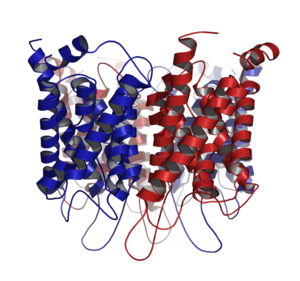Structural Biochemistry/Membrane Proteins/Water Channels
Water Channels
[edit | edit source]
Water channels play a critical role in controlling the water contents of cells. Their connection to water - the essential substance of life - make them pervasive throughout all kingdoms of life.
Water channels can also be referred to as aquaporins. They do not take part in ion transport at all. Instead, these channels increase the rate at which water flows through membranes. Even though membranes are reasonably permeable to water, these water - specific channels are required because in certain tissues rapid water transport through the membranes is necessary. For example, in the kidneys water must be quickly reabsorbed into the bloodstream after filtration.
Water channels (aquaporin) were discovered by Peter Agre. He noticed a protein present at high levels in red blood cell membranes. The protein was found to be present in large quantities in red blood cells and tissues such as kidneys and corneas. This 24-kd membrane protein was actually a water channel.
Water channels or aquaporins in the cell membrane form tetramers that assist in transporting H2O across the cell membrane. Occasionally, some small solutes such as glycerol may cross over as well. Water channels are impermeable to other charge molecules such as protons. This is key to maintain the electrochemical equilibrium. Water channels (aquaporins) consist six membrane-spanning segments. They are located in the plasma membrane as homotetramers, and each of the segments are made up of 2 hemi-pores that form the aquaporins when folded together. Aquaporin's molecular structure makes sure that ions don't pass between the cells. The channel is made of more than 100,000 atoms, that come together to create a structure that sends water molecules through the channel in a single file line. This is done by orienting the molecules in an electric field that is produced by the channel wall. The positive charged formed in the center of the channel repels any unwanted protons from entering through the channel.
Structure
[edit | edit source]The protein consists of six membrane - spanning alpha helices. There are five interhelical loop regions that form the extracellular and cytoplasmic vestibules. Two of the loops are hydrophobic which contain the highly conserved Asn-Pro-Ala, which overlap the middle of the lipid bilayer of the membrane forming a 3-D 'hourglass' structure where the water flows through. The water molecules pass through in single file at rate of 106 molecules per second. Specifically, positively charged residues toward the center of the channel prevent the transport of protons through aquaporin. Therefore, aquaporin channels will not disrupt protein gradients.
Mechanism of Water Transport
[edit | edit source]One characteristic that interest researchers about the aquaporins is that the channels only permits the transport of water and other small non-charged solutes across the membrane. All charged species, such as protons, are completely impermeable in the channel. Based on hydrophobicity plots of their amino acids sequences (structure determines function!), each aquaporin monomer contains two hemi-pores, which fold together to form a water channel. The water molecules work their way through the narrow channel in a single file by orienting themselves in the local electrical field established by the atoms of the channel wall. The strictly opposite orientations of the water molecules ensures the lowest electrostatic repulsion between the water and the wall, thereby allowing the water molecules through to the other side. Charged species, on the other hand, are stopped and rejected out of the channel once they reach the positively charged center.
Water permeation through aquaporins is a passive process that relies on the direction of osmotic pressure across the membrane. Although many water channels are always open, a subgroup of aquaporins has evolved a complex mechanism (mainly involves covalent modification phosphorylation and change in pH) through which the channel can be closed in response to harsh conditions of the environment, under which water exchange can be harmful to the organism.
After primary urine exits the glomerulus of the kidney it passes through winding tubes where about 70% of the water is reabsorbed to the blood by the aquaporin 1 protein. Another 10% is absorbed after the tubes by aquaporin 2 protein. In addition to water, solutes such as sodium, potassium and chloride ions are also reabsorbed into the blood. Antidiuretic hormone stimulates the transport of aquaporin 2 proteins and hence increases water resorption from the urine. People deficient in this hormone might have a daily urine output of 10-15 liters!
